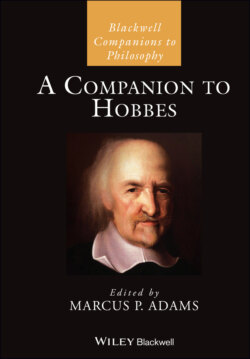Читать книгу A Companion to Hobbes - Группа авторов - Страница 59
Notes
Оглавление1 1 My goal is not to establish the reception or broad influence of Hobbes’s optics. Shapiro (1973) has done so by tracing the influence of Hobbes’s account of refraction and theory of light upon Emmanuel Maignon, Isaac Barrow, and Robert Hooke, among others. See also Malet (2001, 315–17) for discussion of Hobbes’s criticisms of the optics of Claude Mydorge and Walter Warner. On accusations by Seth Ward that Hobbes plagiarized others’ work in his optics, see Prins (1993).
2 2 See Adams (2019) for discussion of this example of “square” and connection to Hobbes’s assertion that humans “make the principles” of civil philosophy. Helen Hattab (this volume, Chapter 1) connects this example to Hobbes’s universal method.
3 3 Adams (2019, 12–13) connects these two routes to Hobbes’s discussion of the individual, “not trusting this Inference, made from the Passions,” who might want to have it “confirmed by Experience” (Hobbes 2012, 194; 1651, 62).
4 4 For discussion of how Hobbes’s view of causality relates to Aristotle’s and to Scholastic Aristotelians, see Leijenhorst (1996).
5 5 Hobbes requires that geometrical definitions be generative, and he rejects Euclidean definitions because they are not (EW VII.184).
6 6 I have modified Gert’s (1994b [1658]) translation to reflect the wording in OL.
7 7 See also Posterior Analytics I.9 (76a4-13; Aristotle 1984, 123) and Metaphysics M.3 1078a14-16 For discussion of Aristotle’s view of subalternate sciences and Galileo, see Lennox (1986).
8 8 Indeed, in Minute Hobbes describes vision “in general” as “that fancie which is caused in any living creature” (1983 [1646], 334). Médina (2016, 42) suggests that the placement of optics within De homine, rather than in De corpore, relates to Hobbes’s division in Minute between illumination (Part I) and vision (Part II) and suggests that this division is similarly reflected in Hobbes’s separation of sciography from optiques in the Table in Leviathan 9 (2012, 131). The former studies consequences “from the Qualities of the Starres” and the latter consequences from the “Qualities of Bodies Terrestriall.” However, were this strict division Hobbes’s intention behind placing optics within De homine (and not within De corpore), it would not explain why De corpore Part IV (chapter XXV) opens with the discussion of “sense”.
9 9 du Verdus to Hobbes (August 17/27, 1656; Hobbes 1994a, 298, 299); Sorbière to Hobbes (December 13/23, 1656; Hobbes 1994a, 388, 391); du Verdus to Hobbes (May 17/27, 1657; Hobbes 1994a, 468, 471); Fermat to Hobbes (June 5/15, 1657; Hobbes 1994a, 474, 475); de Martel to Hobbes (July29/ August 8, 1657; Hobbes 1994a, 480, 482); and de Martel to Hobbes (August 7/17, 1657; Hobbes 1994a, 483, 484).
10 10 Although geometry plays this role in the account of the optic axis and the visual line in De homine, and elsewhere in Hobbes’s optics, geometry does not serve as the “why” in all explanations, such as in Minute where Hobbes’s account of the nature of light plays an explanatory role in understanding the production of heat (see Malet 2001, 320).
11 11 I develop this explanation in more detail in Adams (2016, 47–8). I discuss Hobbes’s borrowing (and citing) of geometrical principles in his criticisms of Robert Boyle in Dialogus Physicus in Adams (2017).
